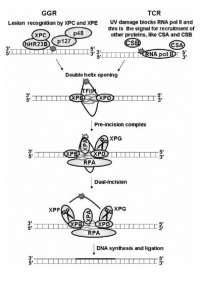Research
From DNA Repair Lab
| Revision as of 15:35, 2 June 2007 Cfmmenck (Talk | contribs) ← Previous diff |
Revision as of 15:36, 2 June 2007 Cfmmenck (Talk | contribs) Next diff → |
||
| Line 20: | Line 20: | ||
| 03. Chiganças V, Sarasin, A and Menck, CF (2004) CPD-photolyase adenovirus-mediated gene transfer in normal and DNA repair deficient human cells. Journal Cell Science 117: 3579-3592. | 03. Chiganças V, Sarasin, A and Menck, CF (2004) CPD-photolyase adenovirus-mediated gene transfer in normal and DNA repair deficient human cells. Journal Cell Science 117: 3579-3592. | ||
| - | 04. Marchetto MCN*, Muotri AR*, Burns DK, Friedberg EC and Menck CFM (2004) Gene transduction in skin cells: preventing cancer in xeroderma pigmentosum mice. Proc. Natl. Acad. Sci. USA 101 (51):17759-17764. Both authors have equally contributed. | + | 04. Marchetto MCN*, Muotri AR*, Burns DK, Friedberg EC and Menck CFM (2004) Gene transduction in skin cells: preventing cancer in xeroderma pigmentosum mice. Proc. Natl. Acad. Sci. USA 101(51), 17759-64. Both authors have equally contributed. |
| 05. Lima-Bessa, KM and Menck, CFM (2005) Skin cancer: lights on genome lesions. Current Biology, 15(2): R58-R61. | 05. Lima-Bessa, KM and Menck, CFM (2005) Skin cancer: lights on genome lesions. Current Biology, 15(2): R58-R61. | ||
Revision as of 15:36, 2 June 2007
DNA Repair Lab
Most of our research activities are based on the understanding of DNA repair and mutagenesis mechanisms in living cells. Several of our approaches include studies on mammalian (basically human) cells in culture, where we try to learn the mechanisms of DNA damage tolerance and removal and cell death (apoptosis) signalling in DNA repair deficient cells (most from the human disease xeroderma pigmentosum). We have developed several recombinant viral vectors (mainly derived from adenovirus), carrying DNA repair genes, which are used in these studies. These vectors are also been used directly in vivo, by infecting DNA repair mice strains, making our lab in the trail for Gene Therapy protocols targeted for skin diseases. Recently, we are developing systems to knock-down DNA repair genes with RNA interference in other to investigate the mechanisms of the interaction of different DNA repair processes. With the recent enormous amount of data generated by genomic approaches, and our own work in genome projects, we have approached the analysis of genome evolution, by using bioinformatics tools. In fact, DNA repair genes are highly conserved and highly appropriated for these studies, as indicated by our work with DNA repair genes in plants. Moreover, based on the knowledge of the complete genome sequence of Caulobacter crescentus, we intend to identify and investigate the genes involved in the DNA repair of this alpha proteobacteria. This bacterial model has been highly useful in studies of cell differentiation and cell cycle in prokaryotes and the possibility to synchronize these bacteria may be useful to ascertain the effect of cell cycle on the repair functions in these cells.
Main recent publications (complete list):
01. Menck, CFM (2002) Shining a light on photolyases. Nature Genetics, News and Views, 32: 338-339.
02. Costa RM, Chiganças V, Galhardo RS, Carvalho H, Menck CFM (2003) The eukaryotic nucleotide excision repair pathway. Biochimie, 85: 1083-1099.
03. Chiganças V, Sarasin, A and Menck, CF (2004) CPD-photolyase adenovirus-mediated gene transfer in normal and DNA repair deficient human cells. Journal Cell Science 117: 3579-3592.
04. Marchetto MCN*, Muotri AR*, Burns DK, Friedberg EC and Menck CFM (2004) Gene transduction in skin cells: preventing cancer in xeroderma pigmentosum mice. Proc. Natl. Acad. Sci. USA 101(51), 17759-64. Both authors have equally contributed.
05. Lima-Bessa, KM and Menck, CFM (2005) Skin cancer: lights on genome lesions. Current Biology, 15(2): R58-R61.
06. Armelini MG, Muotri AR, Marchetto MCN, Lima-Bessa KM, Sarasin A and Menck CFM (2005) Restoring DNA repair capacity of cells from three distinct diseases by XPD gene recombinant adenovirus. Cancer Gene Therapy 12(4): 389-396.
07. Galhardo, RS, Rocha, R. Marques, MV and Menck, CF (2005) A SOS-regulated operon involved in damage-inducible mutagenesis in Caulobacter crescentus. Nucleic Acids Research 33 (8): 2603-2614.
08. Batista LFZ, Chiganças V, Brumatti G, Amarante-Mendes GP and Menck CFM (2006) Involvement of DNA replication in ultraviolet-induced apoptosis of mammalian cells. Apoptosis 11(7): 1139-1148.
09. Lima-Bessa K, Chiganças V, Stary A, Kanouche P, Sarasin A, Armelini MG, Jacysyn JF, Amarantes-Mendes GP, Cordeiro-Stone M, Cleaver JE and Menck CFM (2006). Adenovirus mediated transduction of the human DNA polymerase eta cDNA. DNA Repair 5: 925-934.
